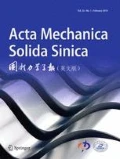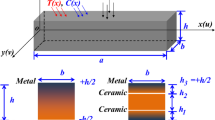Abstract
A visco-elastoplastic damage constitutive model is proposed for simulating nonlinear behavior of concrete. Based on traditional plastic theory, the irreversible deformation is simulated in effective stress space. In order to reflect different stiffness degradation mechanism of concrete under tensile and compressive loading conditions, both tensile and compressive damage variables are introduced, and then on the basis of energy release rate, the model is firmly derived within the concept of irreversible thermodynamics. The rate-dependent model is considered by introducing viscous regularization into the inelastic strain and damage variable, and combined with an additional elastic condition. Fully implicit backward-Euler algorithm is used to perform constitutive integration. Results of numerical examples using the proposed model agree well with test results for specimens under uniaxial tension and compression, biaxial loading and triaxial loading. Failure processes of single-edge-notched (SEN) beam and double-edge-notched (DEN) specimen are also simulated to further validate the proposed model.
Similar content being viewed by others
References
Karsan, D.I. and Jirsa, J.O., Behavior of concrete under compressive loadings. Journal of the Structural Division, 1969, 95(12): 2543–2563.
Kupfer, H., Hilsdorf, H.K. and Rush, H., Behavior of concrete under biaxial stresses. ACI Journal, 1969, 66(8): 656–666.
Gopalaratnam, V.S. and Shah, S.P., Softening response of plain concrete in direct tension. Technical paper ACI Journal Proceedings, 1985, 82(3): 310–323.
Imran, I. and Pantazopoulou, J., Experimental study of plain concrete under triaxial stress. ACI Material Journal, 1996, 93(6): 589–601.
Hussein, A. and Marzouk, H., Behavior of high-strength concrete under biaxial stresses. ACI Materials Journal, 2000, 97(1): 27–37.
Sfer, D., Carol, I., Gettu, R. and Etse, G., Study of the behavior of concrete under triaxia compression. Journal of Engineering Mechanics, 2002, 128(2): 156–163.
Yan, D.M. and Lin, G., Experimental study on concrete under dynamic tensile loading. Journal of Civil Engineering Research and Practice, 2006, 3(1): 1–8.
Lin, F.B., Bazant, Z.P., Chern, J.C. and Marchertas, A.H., Concrete model with normality and sequential identification. Computers and Structures, 1987, 26(6): 1011–1025.
Mazars, J. and Pijaudier-Cabot, G., Continuum damage theory—Application to concrete. Journal of Engineering Mechanics, 1989, 115(2): 345–365.
Hassler-Combe, U. and Hartig, J., Formulation and numerical implementation of a constitutive law for concrete with strain-based damage and plasticity. International Journal of Non-Linear Mechanics, 2008, 43(5): 399–415.
Skrzypek, J. and Ganczarski, A., Application of the orthotropic damage growth rule to variable principal directions. International Journal of Damage Mechanics, 1998, 7(2): 180–206.
Meschke, G., Lackner, R. and Mang, H.A., An anisotropic elastoplastic-damage model for plain concrete. International Journal for Numerical Methods in Engineering, 1998, 42(4): 703–727.
Voyiadjis, G.Z., Taqieddin, Z.N. and Kattan, P.I., Anisotropic damage-plasticity model for concrete. International Journal of Plasticity, 2008, 24(10): 1946–1965.
Allix, O. and Hild, F., Continuum Damage Mechanics of Materials and Structures. Elsevier, Amsterdam, 2002.
Lee, J. and Fenves, G.L., Plastic-damage model for cyclic loading of concrete structures. Journal of Engineering Mechanics, 1998, 24(8): 892–900.
Jason, L., Huerta, A., Pijaudier-Cabot, G. and Ghavamian, S., An elastic plastic damage formulation for concrete: Application to elementary tests and comparison with an isotropic damage model. Computer Methods in Applied Mechanics and Engineering, 2006, 195(52): 7077–7092.
Simo, J.C. and Honein, T., Variational formulation, discrete conservation laws, and path-domain independent integrals for elasto-viscoplasticity. Journal of Applied Mechanics, 1990, 57(3): 488–497.
Simo, J.C. and Hughes, T.J.R., Computational inelasticity. Springer, New York, 1998: 115–120.
Ortiz, M., A constitutive theory for inelastic behaviour of concrete. Mechanics of Materials, 1985, 95(12): 2535–2563.
Faria, R., Oliver, J. and Cervera, M., A strain-based plastic viscous-damage model for massive concrete structures. International Journal of Solids Structures, 1998, 35(14): 1533–1558.
Wu, J.Y., Li, J. and Faria, R., An energy release rate-based plastic-damage model for concrete. International Journal of Solids and Structures, 2006, 43(3–4): 583–612.
Drucker, D.C. and Prager, W., Soil mechanics and plastic analysis for limit design. Quarterly of Applied Mathematics, 1952, 10(2): 157–165.
Lubliner, J., Oliver, J., Oller, S. and Onate, E., A plastic-damage model for concrete. International Journal of Solids Structures, 1989, 25(3): 299–326.
Ottosen, N.S., A failure criterion for concrete. Journal of the Engineering Mechanics Division, 1977, 103(4): 527–535.
Onate, E., Oller, S., Oliver, S. and Lubliner, J., A constitutive model of concrete based on the incremental theory of plasticity. Engineering Computations, 1988, 5(4): 309–319.
Bazant, Z.P. and Pijaudier-Cabot, G., Measurement of characteristic length of nonlocal continuum. Journal of Engineering Mechanics, 1989, 115(4): 755–767.
Trunk, B. and Wittmann, F., Influence of size on fracture energy of concrete. Materials and Structures, 2001, 34(5): 260–265.
Perzyna, P., Fundamental problems in visco-plasticity. Advances in applied mechanics, 1996, 9(2): 244–368.
Duvaut, G. and Lions, J.L., Inequalities in Mechanics and Physics (translated from the French by C. W. John). Springer, New York, 1976.
Cervera, M., Oliver, J. and Manzolia, O., Rate dependent isotropic damage model for the seismic analysis of concrete dams. Earthquake Engineering and Structural Dynamics, 1996, 25(9): 987–1010.
Ju, J.W., On energy-based coupled elastoplastic damage theories: constitutive modeling and computational aspects. International Journal of Solids and Structures, 1989, 25(7): 803–833.
Lee, J. and Fenves, G.L., A return-mapping algorithm for plastic-damage models: 3-D and plane stress formulation. International Journal for Numerical Methods in Engineering, 2001, 50(2): 487–506.
Belytschko, T., Liu, W.K. and Moran, B., Nonlinear Finite Elements for Continua and Structures. John Wiley and Sons, Chichester, 2000: 277–294.
Simo, J.C. and Taylor, R.L., Consistent tangent operators for rate-independent elastoplasticity. Computer Methods in Applied Mechanics and Engineering, 1985, 48(1): 101–118.
Simo, J.C. and Taylor, R.L., A return mapping algorithm for plane stress elastoplasticity. International Journal for Numerical Methods in Engineering, 1986, 22(3): 649–670.
Green, S.J. and Swanson, S.R., Static Constitutive Relations for Concrete. AFWL-TR-72-244, US Air Force Weapons Laboratory, Kirtland Air Force Base, NM. 1973.
Gopalaratnam, V.S. and Shah, S.P., Softening response of plain concrete in direct tension. Technical paper ACI Journal Proceedings, 1985, 82(3): 310–323.
Yan, D. and Lin, G., Dynamic behaviour of concrete in biaxial compression. Magazine of Concrete Research, 2007, 59(1): 45–52.
Peterson, P.E., Crack Growth and Development of Fracture Zones in Plain Concrete and Similar Materials. Report No. TVBM21006, Division of Building Materials, University of Lund, Sweden, 1981.
Meyer, R., Ahrens, H. and Duddeck, H., Material model for concrete in cracked and untracked states. Journal of Engineering Mechanics Division, 1994, 120(9): 1877–1895.
Nooru-Mohamed, M.B., Mixed-mode Fracture of Concrete: An Experimental Approach. PhD thesis, Delft University of Technology, The Netherlands. 1992.
Author information
Authors and Affiliations
Corresponding author
Additional information
Project supported by the Chinese-Germany Science Foundation (No. GZ566) and the National Natural Science Foundation of China (No. 51138001).
Rights and permissions
About this article
Cite this article
Liu, J., Lin, G., Fu, B. et al. The Use of Visco-Elastoplastic Damage Constitutive Model to Simulate Nonlinear Behavior of Concrete. Acta Mech. Solida Sin. 24, 411–428 (2011). https://doi.org/10.1016/S0894-9166(11)60041-4
Received:
Revised:
Published:
Issue Date:
DOI: https://doi.org/10.1016/S0894-9166(11)60041-4




